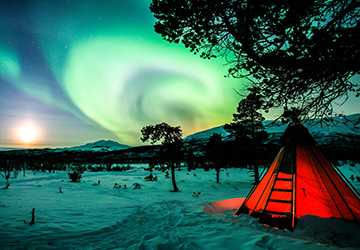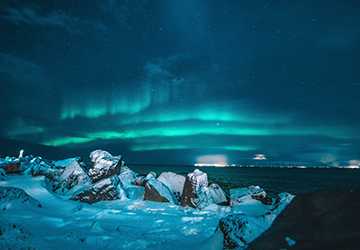Unveiling the Magic of the Northern Lights: A Travelers Guide
The Northern Lights, also known as the Aurora Borealis, are one of nature's most spectacular displays. This Northern Lights travel guide aims to help adventurers embark on a journey to witness this celestial dance of colours in the night sky. Understanding how to see the Northern Lights involves more than just heading north; it requires planning, patience, and a bit of luck. The experience of seeing the Northern Lights is profound, offering a unique blend of natural wonder and cosmic mystery.

Best Time for Northern Lights: Maximizing Your Chances
Knowing the best time for Northern Lights viewing is crucial when planning your expedition. Generally, the optimal period is from late September to early April, when the nights are the longest in the Arctic Circle. The best time for Northern Lights sightings often coincides with clear, dark skies, usually found in winter. However, the lights are unpredictable, so flexibility in your travel schedule can be advantageous.
Location Insights: How to See Northern Lights
Choosing the correct location is vital to any Northern Lights travel guide. Areas within the Arctic Circle, such as Northern Norway, Iceland, Finland, and parts of Canada and Alaska, are prime spots for observing the lights. Each of these destinations offers its own unique set of experiences and advantages. For instance, Norway's coastal areas provide stunning reflections of the lights on the ocean, while the inland regions of Finland offers clear skies and snowy landscapes as backdrops.
Preparing for the Northern Lights Adventure
Understanding how to see the Northern Lights also involves proper preparation. It is essential to dress warmly in layers, as nights can be freezing. In addition, a good Northern Lights travel guide will recommend equipment such as a camera with manual settings to capture the lights and tripods for stability. Moreover, patience is essential; you may need to wait several hours in the cold to glimpse the lights.
Cultural and Scientific Aspects of the Northern Lights
The Northern Lights are a natural phenomenon and a cultural and scientific wonder. Many cultures have myths and legends about the lights, adding a mystical element to the experience. From a scientific perspective, the lights result from solar particles colliding with the Earth's atmosphere, creating a dazzling display of colours. This fusion of science and folklore makes the Northern Lights travel guide an intriguing read for avid travellers and curious minds.
Photographing the Northern Lights: Tips and Techniques
Capturing the Northern Lights in photographs is a dream for many travellers. A good Northern Lights travel guide often includes photography tips to help you immortalize the moment. Using a camera with manual settings is crucial, allowing you to adjust the exposure for the best shot. A tripod is essential to avoid camera shake in long exposures. Experimenting with different shutter speeds and apertures is recommended for the best results. Remember, the aurora can be fast-moving, so being prepared and patient is crucial in capturing this magnificent natural phenomenon.
Combining Northern Lights Viewing with Unique Local Experiences
Consider combining Northern Lights viewing with other local experiences to make the most of your journey. In destinations like Iceland or Norway, you can pair the aurora hunt with activities like glacier hiking, hot spring visits, or cultural tours. This approach not only maximizes your chances of seeing the lights but also enriches your travel experience, making your trip about more than just the best time for the Northern Lights; it becomes a comprehensive exploration of the destination.

Understanding the Science Behind the Northern Lights
A scientific understanding of the aurora can enhance your appreciation of this natural wonder. The lights are the result of solar winds interacting with the Earth's magnetosphere, creating vivid colours that light up the sky. Each colour corresponds to different gas particles in the Earth's atmosphere. This scientific insight adds depth to the experience, making your pursuit of how to see Northern Lights, not just a visual journey but an educational one as well.
Selecting the Perfect Spot for Northern Lights Viewing
Knowing the best time for the Northern Lights is crucial, as is choosing the correct location. Your Northern Lights travel guide should offer insights on the best vantage points. Remote areas away from light pollution are ideal. Elevated regions can provide a broader view of the sky, increasing your chances of a sighting. Some locations even offer guided tours, where experts can take you to the best spots and share.
Cultural Significance of the Aurora in Local Communities
In many cultures, the Northern Lights hold significant historical and spiritual meaning. Indigenous communities in the Arctic regions often have folklore and myths surrounding the aurora, viewing it as a sacred phenomenon. Learning about these cultural perspectives can add a rich layer of understanding and appreciation to your Northern Lights travel guide experience.
Conclusion
In conclusion, chasing the Northern Lights is an adventure like no other. With proper planning, understanding the best time for the Northern Lights, and preparing accordingly, witnessing this natural wonder can be a life-changing experience. As this Northern Lights travel guide outlines, the journey to see the Aurora Borealis is not just about the destination.
FAQ's
FAQ 1: What Are Some Effective Techniques for Photographing the Northern Lights?
Answer: To photograph the Northern Lights effectively, use a camera with manual settings and a tripod to manage long exposures. Experiment with shutter speeds and apertures to capture the fast-moving aurora. Shooting in a remote area away from light pollution can also enhance the quality of your photos.
FAQ 2: How Can Travelers Enhance Their Northern Lights Experience Beyond Just Viewing?
Answer: Travelers can enhance their Northern Lights experience by combining aurora viewing with local activities such as cultural tours, glacier hikes, or hot spring visits. This approach enriches the trip, blending natural wonder and artistic exploration.

